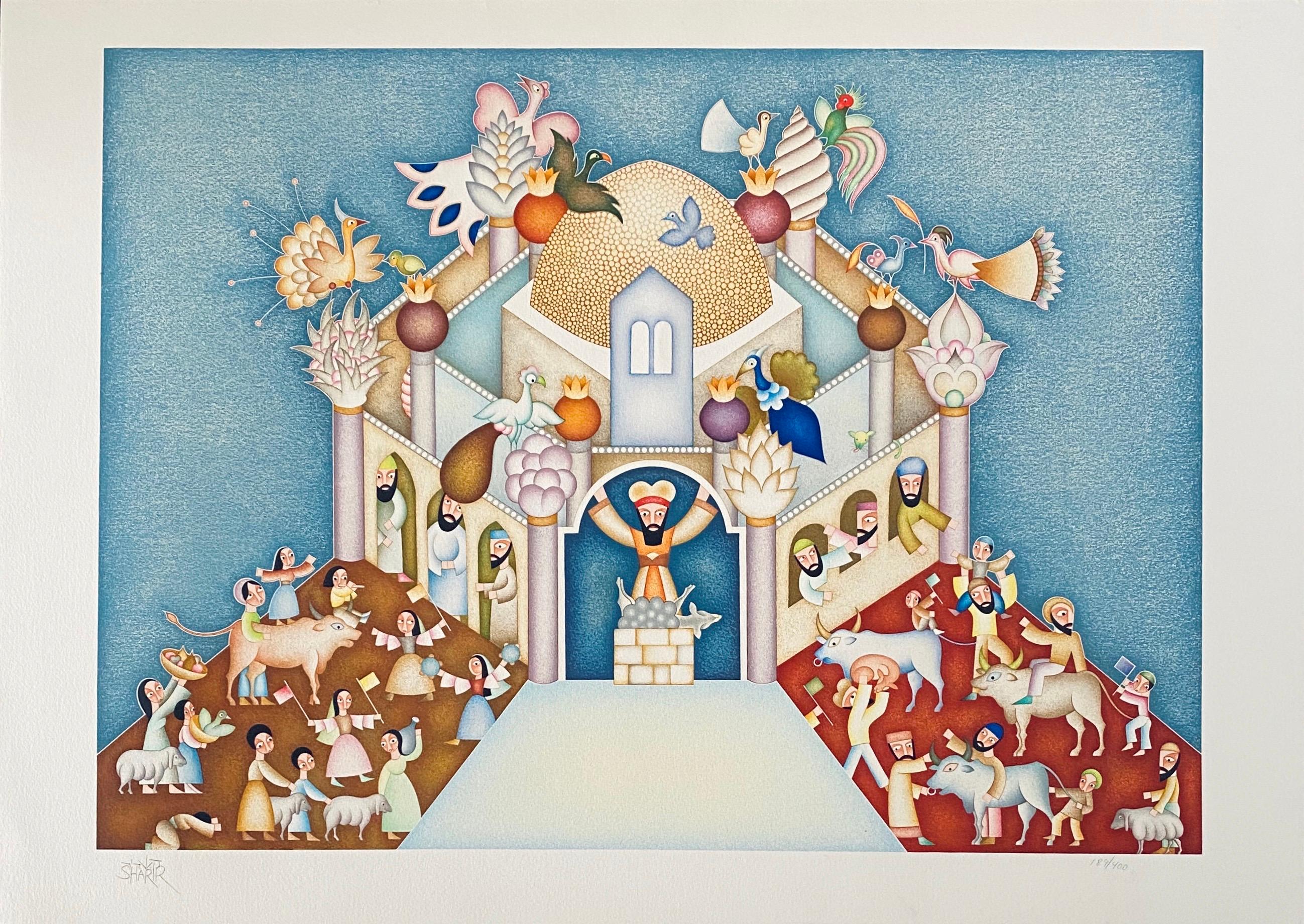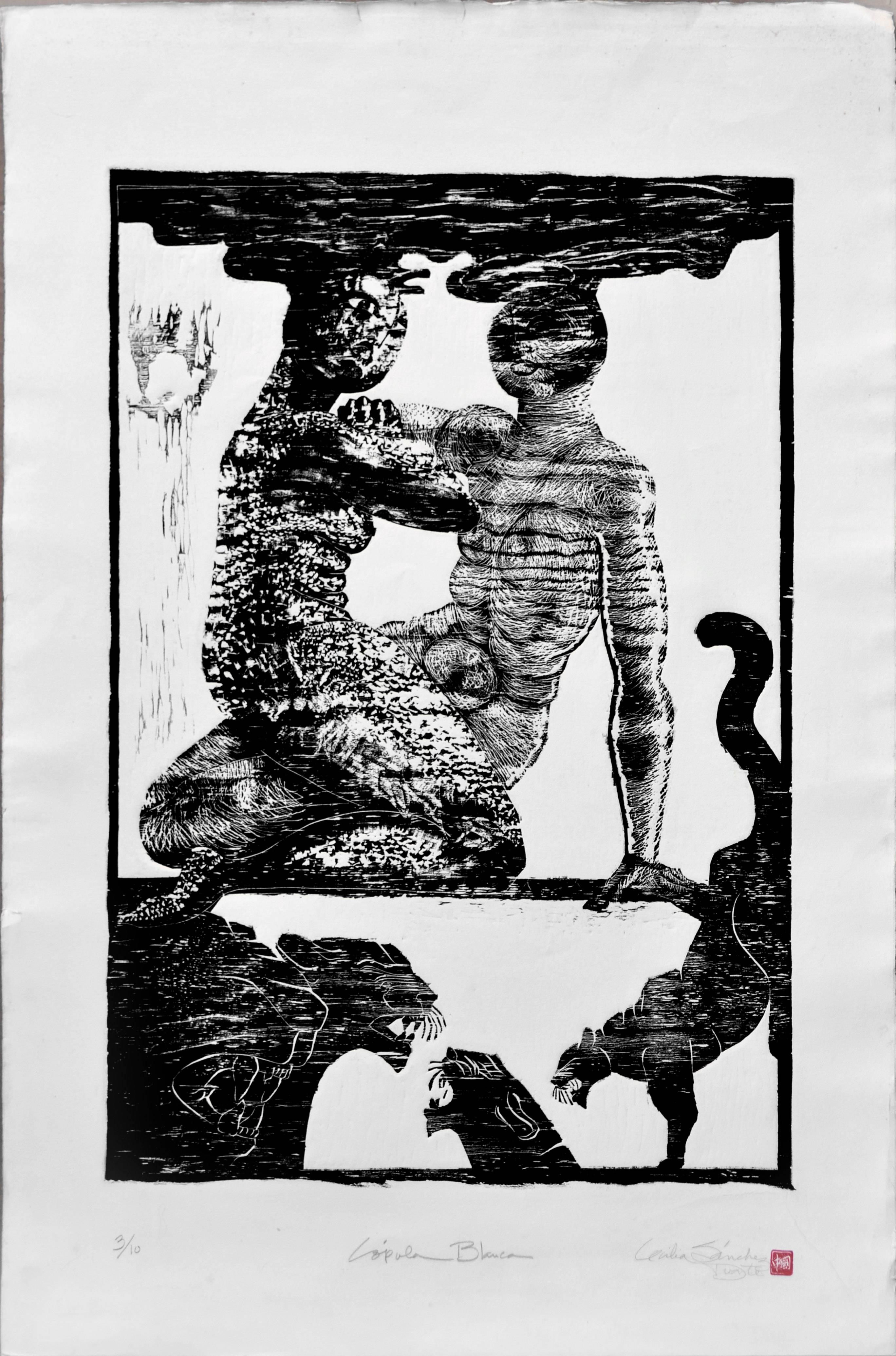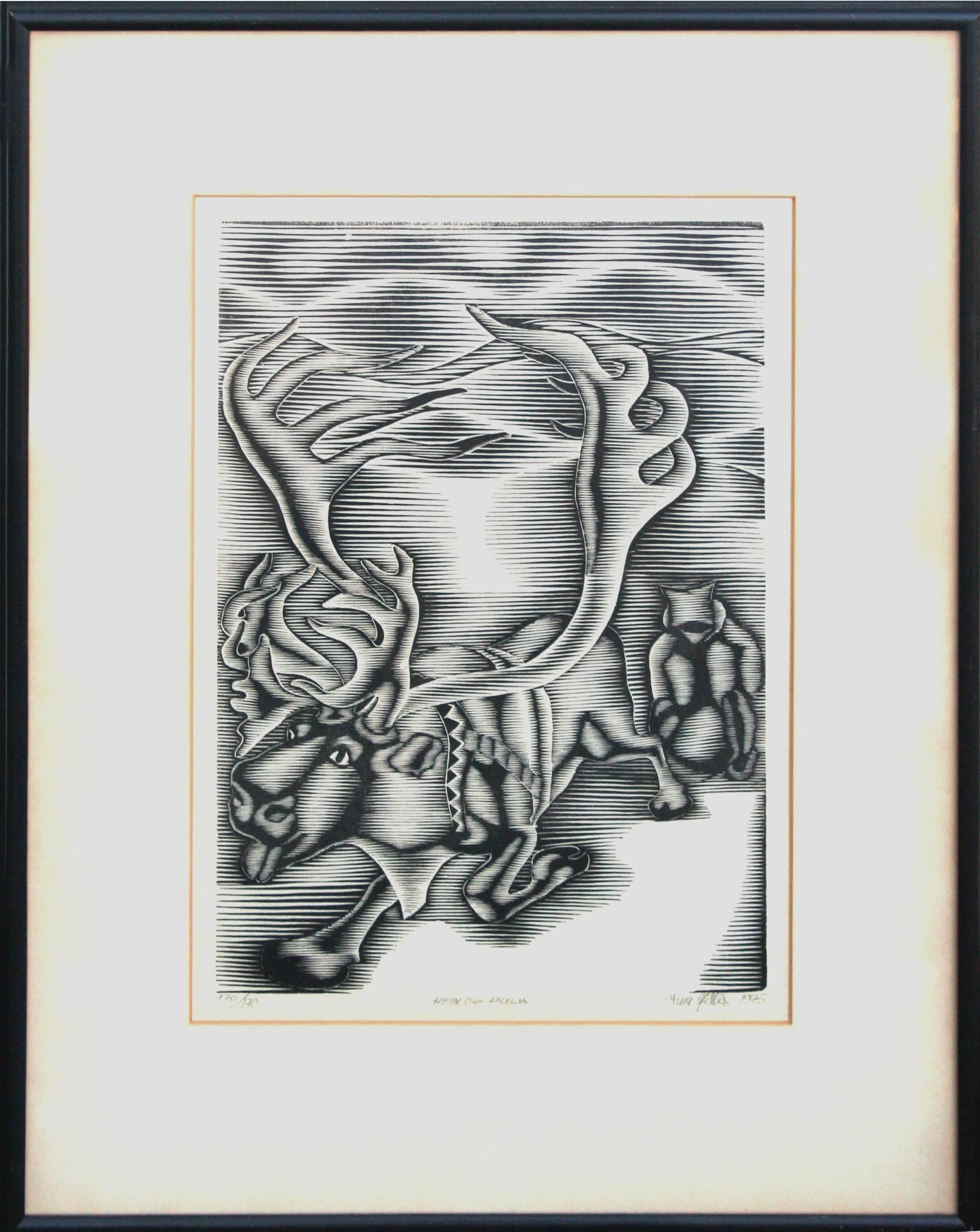Items Similar to Feeding the Ravens
Want more images or videos?
Request additional images or videos from the seller
1 of 10
Rie MunozFeeding the Ravens1997
1997
About the Item
This artwork titled "Feeding the Ravens" 1997 is a color offset lithograph on paper by noted American artist Rie Mounier Munoz, 1921-2015. It is hand signed and numbered 29/950 in pencil by the artist. The image size is 9.65 x 8.35 inches, sheet size is 13.85 x 12.25 inches. It is in excellent condition, has never been framed.
About the artist:
Alaska painter Rie Mounier Munoz was the child of Dutch parents who immigrated to California, where she was born and raised. She is known for her colorful scenes of everyday life in Alaska.
Rie (from Marie) Munoz (moo nyos), studied art at Washington and Lee University in Virginia. In 1950, she traveled up the Inside Passage by steamship, fell in love with Juneau, and gave herself until the boat left the next day to find a job and a place to live. Since then Juneau has been home to Munoz. She began painting small vignettes of Alaska soon after arriving in Juneau, and also studied art at the University of Alaska-Juneau.
Munoz painted in oils in what she describes as a "painstakingly realistic" style, which she found stiff and "somewhat boring." Her breakthrough came a few years later when an artist friend introduced her to a versatile, water-soluble paint called casein. The immediacy of this inexpensive medium prompted an entirely new style. Rie's paintings became colorful and carefree, mirroring her own optimistic attitude toward life. With her newfound technique she set about recording everyday scenes of Alaskans at work and at play.
Of the many jobs she has held journalist, teacher, museum curator, artist, mother, Munoz recalls one of her most memorable was as a teacher on King Island in 1951, where she taught 25 Eskimo children. The island was a 13-hour umiak (a walrus skin boat) voyage from Nome, an experience she remembers vividly. After teaching in the Inupiat Eskimo village on the island with her husband during one school year, she felt a special affinity for Alaska's Native peoples and deliberately set about recording their traditional lifestyles that she knew to be changing very fast.
For the next twenty years, Rie practiced her art as a "Sunday painter," in and around prospecting with her husband, raising a son, and working as a freelance commercial artist, illustrator, cartoonist, and curator of exhibits for the Alaska State Museum. During her years in Alaska, Munoz has lived in a variety of small Alaskan communities, including prospecting and mining camps.
Her paintings reflect an interest in the day-to-day activities of village life such as fishing, berry picking, children at play, as well as her love of folklore and legends. Munoz says that what has appealed to her most were "images you might not think an artist would want to paint," such as people butchering crab, skinning a seal, or doing their laundry in a hand-cranked washing machine.
In 1972, with her hand-cut stencil and serigraph prints selling well in four locations in Alaska, she felt confident enough to leave her job at the Alaska State Museum and devote herself full time to her art. Freed from the constraints of an office job, she began to produce close to a hundred paintings a year, in addition to stone lithograph and serigraph prints.
From her earliest days as an artist, Rie had firm beliefs about selling her work. First, she insisted the edition size should be kept modest. When she decided in 1973 to reproduce Eskimo Story Teller as an offset lithography print and found the minimum print run to be 500, she destroyed 200 of the prints. She did the same with King Island, her second reproduction. Reluctantly, to meet market demand, she increased the edition size of the reproductions to 500 and then 750. The editions stayed at that level for almost ten years before climbing to 950 and 1250.
Her work has been exhibited many solo watercolor exhibits in Alaska, Oregon and Washington State, including the Charles and Emma Frye Art Museum, Alaska State Museum in Juneau, Anchorage Historical and Fine Arts Museum, Tongass Historical Museum in Ketchikan, and Yukon Regional Library in Whitehorse; Yukon Territory, and included in exhibits at the Smithsonian Institute and Russell Senate Office Building in Washington, D.C.
Munozs paintings have graced the covers of countless publications, from cookbooks to mail order catalogs, and been published in magazines, newspapers, posters, calendars, and two previous collections of her work: Rie Munoz, Alaskan Artist (Alaska Northwest Publishing Company, 1984) and Rie Munoz, Artist in Alaska (Rie Munoz Ltd., 1987). Galleries throughout the U.S. and Canada, as well as in Norway, Japan, England, and Holland carry her reproductions and original prints.
Although Rie usually paints Alaskan subjects, collectors of her work live across the nation. Many collect thematically, such as focusing on images of Russian churches, for example, or all the bird prints, or the self-portraits.
- Creator:Rie Munoz (American)
- Creation Year:1997
- Dimensions:Height: 13.85 in (35.18 cm)Width: 12.25 in (31.12 cm)Depth: 0.01 in (0.26 mm)
- Medium:
- Movement & Style:
- Period:
- Condition:
- Gallery Location:San Francisco, CA
- Reference Number:
About the Seller
5.0
Platinum Seller
These expertly vetted sellers are 1stDibs' most experienced sellers and are rated highest by our customers.
Established in 1999
1stDibs seller since 2017
683 sales on 1stDibs
Typical response time: 1 hour
- ShippingRetrieving quote...Ships From: San Francisco, CA
- Return PolicyA return for this item may be initiated within 7 days of delivery.
More From This SellerView All
- Leading the RemudaLocated in San Francisco, CAThis artwork titled "Leading the Remuda" c.1970 is an original lithograph on Wove paper by noted western artist Tom (Thomas) Ryan, 1922-2011. It is hand signed, titled and numbered 58/100 in pencil by the artist. The artwork (image) size is 12.25 x 17.35 inches, sheet size is 17.5 x 21.65 inches. It is in excellent condition About the artist: Tom Ryan was born Jan. 12, 1922, in Springfield, Ill., to William Martin Ryan — whose family immigrated to Illinois from Ireland in the 1880s — and Sarah Helen Behrens, whose ancestry predates the Revolutionary War. They had nine children — six boys and three girls. He began drawing before he went to school. "I was 4 years old and drawing airplanes, and an older brother was helping me," Ryan told the Reporter-Telegram in a 2002 interview at the Haley Library's going away party held in his honor. "Those were my first art lessons." He did not decide to be an artist until after his service in World War II. While in the U.S. Navy during the war, he "made quite a bit of money" drawing portraits of his shipmates and other servicemen. After being discharged in 1945, he picked up a Life magazine that carried an article about N.C. Wyeth. "I read the article, and I liked what I read, and I loved the pictures reproduced from his paintings in the article," Ryan said in 2002. "I decided then and there to be an artist." Following his graduation from the American Academy of Art, an education made possible through the GI Bill, he returned to Springfield where he married Jacqueline "Jacquie" Harvey, daughter of a local doctor. She died in 1998. The Ryans moved to New York City where he continued his studies at the Art Students League. During his second year at the Art Students League, he won a contest. His winning painting became the cover for Western writer Ernest Haycox's novel The Outlaw. "Every month after that I also received an assignment from this publisher, and they would be Western novels," Ryan said in 2002. "So that's what I did for the next six or seven years. Then I started exhibiting at the Latendorf Gallery on Madison Avenue. What I sold mainly were the book covers. They would be published and I would get paid by the publisher, and I'd take them to the gallery, and I'd get paid again." Ryan began making trips west in the late 1950s. He would stay three or four months painting, sketching and photographing scenes he'd need later. At that time, his works centered around historical events and places. "I particularly liked to do some of the trail drive things that I did, like the old longhorns," Ryan said in 2002. In the early 1960s, a work by Norman Rockwell and one by Ryan appeared in the same catalog. Rockwell, who was doing the Boy Scouts calendars for Brown and Bigelow, the premiere calendar publishing company in the United States, told the calendar company about Ryan. "The art director gave me a call and asked if I'd like to do a contemporary cowboy...Category
Late 20th Century American Realist Figurative Prints
MaterialsLithograph
- HorsemenBy William GropperLocated in San Francisco, CAThis artwork titled "The Horsemen" 1935, is an original lithograph on paper by noted American artist William Gropper, 1897-1977. It is hand signed in pencil by the artist. The artwor...Category
Mid-20th Century American Realist Figurative Prints
MaterialsLithograph
- Au ReposBy Graciela Rodo BoulangerLocated in San Francisco, CAThis artwork titled "Au Repos (At Rest)" 1983 is an original color lithograph on paper by noted Bolivian artist Graciela Rodo Boulanger, b.1935. It is hand signed and numbered 157/20...Category
Late 20th Century Modern Figurative Prints
MaterialsLithograph
- Soaking UpLocated in San Francisco, CAThis artwork titled "Soaking Up" c.1970 is an original lithograph on Wove paper by noted western artist Tom (Thomas) Ryan, 1922-2011. It is hand signed, titled and numbered 68/100 in pencil by the artist. The artwork (image) size is 12.25 x 17.35 inches, sheet size is 17.5 x 21.65 inches. It is in excellent condition About the artist: Tom Ryan was born Jan. 12, 1922, in Springfield, Ill., to William Martin Ryan — whose family immigrated to Illinois from Ireland in the 1880s — and Sarah Helen Behrens, whose ancestry predates the Revolutionary War. They had nine children — six boys and three girls. He began drawing before he went to school. "I was 4 years old and drawing airplanes, and an older brother was helping me," Ryan told the Reporter-Telegram in a 2002 interview at the Haley Library's going away party held in his honor. "Those were my first art lessons." He did not decide to be an artist until after his service in World War II. While in the U.S. Navy during the war, he "made quite a bit of money" drawing portraits of his shipmates and other servicemen. After being discharged in 1945, he picked up a Life magazine that carried an article about N.C. Wyeth. "I read the article, and I liked what I read, and I loved the pictures reproduced from his paintings in the article," Ryan said in 2002. "I decided then and there to be an artist." Following his graduation from the American Academy of Art, an education made possible through the GI Bill, he returned to Springfield where he married Jacqueline "Jacquie" Harvey, daughter of a local doctor. She died in 1998. The Ryans moved to New York City where he continued his studies at the Art Students League. During his second year at the Art Students League, he won a contest. His winning painting became the cover for Western writer Ernest Haycox's novel The Outlaw. "Every month after that I also received an assignment from this publisher, and they would be Western novels," Ryan said in 2002. "So that's what I did for the next six or seven years. Then I started exhibiting at the Latendorf Gallery on Madison Avenue. What I sold mainly were the book covers. They would be published and I would get paid by the publisher, and I'd take them to the gallery, and I'd get paid again." Ryan began making trips west in the late 1950s. He would stay three or four months painting, sketching and photographing scenes he'd need later. At that time, his works centered around historical events and places. "I particularly liked to do some of the trail drive things that I did, like the old longhorns," Ryan said in 2002. In the early 1960s, a work by Norman Rockwell and one by Ryan appeared in the same catalog. Rockwell, who was doing the Boy Scouts calendars for Brown and Bigelow, the premiere calendar publishing company in the United States, told the calendar company about Ryan. "The art director gave me a call and asked if I'd like to do a contemporary cowboy...Category
Late 20th Century American Realist Figurative Prints
MaterialsLithograph
- Soaking UpLocated in San Francisco, CAThis artwork titled "Soaking Up" c.1970 is an original lithograph on paper by noted western artist Tom (Thomas) Ryan, 1922-2011. It is hand signed, titled and numbered 68/100 in penc...Category
Late 20th Century American Realist Figurative Prints
MaterialsLithograph
- Horses #IVBy Hoi LebadangLocated in San Francisco, CAThis artwork "titled "Horses #IV" 1974 is an original color lithograph, with embossing by French/Vietnamese artist Hoi Lebadang, 1922-2015. It is hand sig...Category
Late 20th Century Modern Animal Prints
MaterialsLithograph
You May Also Like
- Feast and singing. 1984. Paper, linocut, 20x34 cmBy Dainis RozkalnsLocated in Riga, LVFeast and singing. 1984. Paper, linocut, 20x34 cm imprint size 10x26 cm total page size 20x34cm Dainis Rozkalns (1928 - 2018) Artist, graphic artist, illustrator of folklore and fi...Category
1980s Folk Art Figurative Prints
MaterialsPaper, Linocut
- Israeli Naive Folk Art Birdhouse Silkscreen Lithograph David Sharir BirdsBy David SharirLocated in Surfside, FLDavid Sharir was born in 1938 in Tel Aviv, Israel and currently resides there. David Sharir, the son of Russian immigrants, was born in Israel. Beginning his study of art in Tel Aviv and continuing in Florence and Rome, where he studied architecture and theater design. The brightly colored costumes and intricate stage designs he created for these productions have profoundly influenced his art. When Sharir moved to Old Jaffa in 1966, his hallmark style was truly developed. Studio, family, and spiritual devotion all serve as inspiration for the imagery in his work. His evolving style combines personal experience, Biblical symbolism, and fantasy. Israel has had a Vibrant Folk Art, Naive art scene for a long time now artists like Yisrael Paldi, Nahum Guttman, Reuven Rubin and even Yefim Ladyzhensky had naive periods. The most well know if the strict naive artists are Shalom of Safed, Irene Awret Gabriel Cohen, Natan Heber, Michael Falk Kopel Gurwin. Sharir depicted biblical subjects with a touch of humour and designed sets and costumes for the theatre and opera. Graphic Art in Israel Today Tel Aviv Museum, Tel Aviv 1973 Israel 1948-1958: Watercolors, Drawings, Graphics The Bezalel National Museum, Jerusalem 1958 Jean David, Yosl Bergner, Menachem Shemi, Zvi Mairovich, Ruth Schloss, Nahum Gutman...Category
20th Century Folk Art Figurative Prints
MaterialsScreen
- Israeli Naive Folk Art Silkscreen Lithograph David Sharir - Bet Hamikdash SceneBy David SharirLocated in Surfside, FLDavid Sharir was born in 1938 in Tel Aviv, Israel and currently resides there. David Sharir, the son of Russian immigrants, was born in Israel. Beginning his study of art in Tel Aviv and continuing in Florence and Rome, where he studied architecture and theater design. The brightly colored costumes and intricate stage designs he created for these productions have profoundly influenced his art. When Sharir moved to Old Jaffa in 1966, his hallmark style was truly developed. Studio, family, and spiritual devotion all serve as inspiration for the imagery in his work. His evolving style combines personal experience, Biblical symbolism, and fantasy. Israel has had a Vibrant Folk Art, Naive art scene for a long time now artists like Yisrael Paldi, Nahum Guttman, Reuven Rubin and even Yefim Ladyzhensky had naive periods. The most well know if the strict naive artists are Shalom of Safed, Irene Awret Gabriel Cohen, Natan Heber, Michael Falk Kopel Gurwin. Sharir depicted biblical subjects with a touch of humour and designed sets and costumes for the theatre and opera. Graphic Art in Israel Today Tel Aviv Museum, Tel Aviv 1973 Israel 1948-1958: Watercolors, Drawings, Graphics The Bezalel National Museum, Jerusalem 1958 Jean David, Yosl Bergner, Menachem Shemi, Zvi Mairovich, Ruth Schloss, Nahum Gutman...Category
20th Century Folk Art Figurative Prints
MaterialsScreen
- Panther - Figurative Abstract Woodcut, 3/10By Cecelia Sánchez DuarteLocated in Soquel, CAFigurative abstract wood cut print titled "Copula Blanca" by Cecelia Sánchez Duarte. Pencil signed with edition number "3/10," title, and signature bottom margin. Image, 31.25"H x 23...Category
1990s Folk Art Figurative Prints
MaterialsArchival Paper, Woodcut
- Frontline and Homefront diptychBy Harry BunceLocated in Deddington, GBHarry Bunce Love Wars Series, Frontline Limited Edition Hand Pulled Silkscreen Image Size: H 63cm x W 49cm x D 0.1cm Mounted Size: H 73cm x W 59cm x 0.5cm So...Category
21st Century and Contemporary Folk Art Animal Prints
MaterialsPaper, Screen
- Rein Og Pulk (Reindeer and Sleighs) - Laplander Sami in his PulkBy Yuri MotLocated in Soquel, CAJoyful image of a woodcut print of a Reindeer pulling a Laplander Sami in his Pulk (small toboggan), a traditional scene in Lapland folklore and history by Yuri Mot. Signed indistinc...Category
1970s Folk Art Figurative Prints
MaterialsWoodcut, Laid Paper
Recently Viewed
View AllMore Ways To Browse
King Of The Animals
Russian Church
Vintage Feed
Newspaper Poster
Boat On Water Print
Seal Animal
Japanes Bird Print
Japanese Prints Birds
Folk Art Church
The Senate
Love Story Poster
Folk Painted Mirror
Vintage Calendar Prints
Vintage Calendar Print
Vintage Climbing Frame
Alaska Vintage
Native American Posters
Retro Library Posters




